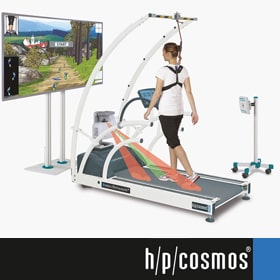

The zebris Rehawalk® system is designed for the analysis and treatment of gait disorders in neurologic, orthopaedic or geriatric rehabilitation. In addition to a treadmill, Rehawalk® includes a unit for adaptive visual cueing through the projection of gait patterns on the treading surface. Virtual feedback training happens simultaneously with the help of a large monitor mounted in front of the treadmill.
integrated pressure sensor matrix
The system is based on the proven h/p/cosmos treadmill systems that are available in different sizes and feature variations. The treadmills can, for example, be equipped with arm support and a safety arch. Underneath the belt, a pressure sensor matrix is installed featuring several thousand calibrated, capacitive pressure sensors. The belt movement is compensated such that stable gait and roll-off parameters can be analyzed.
By using an integrated un-weighting system, it is possible to commence the locomotion therapy at an early stage. As a complete system, the h/p/cosmos locomotion 150/50 DE med additionally offers adjustable handrails, a wheelchair ramp and therapist seats.
balance analysis, balance training, visual stimulation
A module for stance and balance analysis as well as balance training is optionally available. Therapy with Rehawalk® assists patients in reaching a safe and effective gait through functional and cognitive challenges that can be individually adapted to the patient’s capability. Due to the high number of step repetitions, an automation of motion sequences is achieved providing complete protection against falling and additional weight unloading at the same time. The system automatically documents the course of treatment through the easy-to-operate software and in-depth evaluation reports. For recording kinematic parameters and video documentation, an integrated lighting and camera unit is optionally available.
gait training using adaptive visual cueing
The initial gait analysis is carried out without any measuring preparations to be done on the patient. The measuring process can be observed on the screen in real-time. The report is automatically generated. In order to prepare the gait training using adaptive visual cueing, the parameters from the gait analysis (step length, step width and foot rotation) are automatically populated and can be individually adjusted according to the training objectives. The values remain constant or gradually approach the target settings during the course of the training. During training the steps are projected onto the treadmill belt in the shape of the actual footprints, or alternatively as rectangles. Throughout the gait training the patient is instructed to position his or her feet as accurately as possible within the projected surface area. Training is possible when using an un-weighting system and thus also allows for patients who are suffering from severe functional limitations to commence therapy even at an early stage. The success report documents the adherence to the target settings. On that basis, the target parameters can be adjusted to the patient’s capability. For an optimal training control, two gait analyses are compared, e.g. before and after a training period.
gait and coordination training using virtual feedback
Physical and cognitive abilities are simultaneously demanded during dual-task-training in the virtual walking environment. The patient solves simple perceptual and memory tasks as well as arithmetic problems while walking and observing his or her footprints. Thus, reaction time and attentiveness are improved while simultaneously supporting automated walking. The various modules allow the training to be individually adapted to each patient.